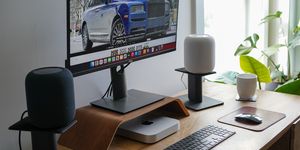I'm relatively new to subwoofers. We didn't have one in our house growing up — my parents didn't have fancy home theater or hi-fi systems. Nor did I put one in the trunk of my car like so many of my high school friends. I just wasn't that guy.
But things have changed in recent years. As I've lived on my own and as my job has educated me in the ways of hi-fi, I've learned that subwoofers are all about more than just the bass. While that's technically true — subwoofers exclusively handle low-end frequencies (aka bass) typically between 20 and 200Hz — they also elevate the sound of your entire system as your other speakers can focus more on the high and midrange frequencies.
I've experienced this phenomenon firsthand. After years of holding out, about two years ago I pulled the trigger on Sonos's biggest subwoofer, the Sub, and paired it with my Arc soundbar. Yes, it's ridiculously expensive — the Sub is basically the same price as the Arc — but I absolutely love it.
My house rumbles while watching Liverpool games. I frequently have watch parties for Star Wars shows (Ahsoka and The Mandalorian) and action films such as Top Gun and Mission Impossible. The subwoofer makes my soundbar system sound bigger, bolder, more immersive ... and a bit spooky as there are times you pick up a rumble from somewhere you don't expect. I've liked my subwoofer so much that I got another one, Sonos's smaller Sub Mini, for the Beam soundbar in my office.
Now, a subwoofer in a home theater (or even a hi-fi) system is one thing. A subwoofer in a desktop audio system is something entirely different. Instead of sporting events and blockbuster films, you're watching YouTube videos or attending Zoom meetings — typically not the type of situations where you need a bangin' audio system. But that's exactly what I've experienced the past few weeks while testing Kanto's newest powered computer speaker, the Ora ($349), and wired subwoofer, the Sub8 ($270). And I've got to admit, I kind of love it.
On their own, the Kanto Oras are a bit more "reference quality" than your average computer speakers. Each speaker has a 1/4-inch silk dome tweeter and 3-inch mid-woofer, and together they have 100 watts of peak power (aka, they get very loud). They can also play lossless audio (up to 24-bit/96kHz) when connected to your computer via USB-C; they support RCA connections and Bluetooth streaming, too.
I'm a big fan of badass speaker setups for your computer — I've turned large active speakers and passive bookshelf speakers (along with a speaker amp) into computer speakers — but I had never used a separate subwoofer ... and the Sub8 takes the Oras to another level.
The Sub8 is an 8-inch front-firing woofer with 300 watts of peak power and a frequency response that gets as low as 35Hz — by themselves, the Oras get as low as 70Hz. It's also a sealed subwoofer (instead of ported), which allows its cabinet size to get smaller and thus it can fit in tighter spaces ... like under your desk.
Unlike the Oras, which lack customizable features (there's no companion app for adjusting the EQ, for example), the Sub8 does allow for some tinkering. On the back of the subwoofer, you'll find dial controls for adjusting the level (or volume/power) and crossover, as well as a phase switch in case you need to position the subwoofer farther away from your speakers.
Because the Oras and Sub8 are meant to pair with one another, the only thing I really played around with was the level. But even at 50 percent, the Sub8 rumbles the floor. It makes you feel like you're there when listening to a Springsteen concert (or watching live shows on YouTube). And if you're somebody who watches movies on your desktop, it can become downright immersive.
For the vast majority of my testing, I had the Sub8's level set to about 40 percent. I like bass, but when I work I listen to a lot more indie rock and pop, like London Grammar and Lana Del Rey, as well as acoustic-ish rock like Pearl Jam and Nirvana, and found that lifting the Sub8's level to any higher was a little overpowering. Cranking the bass to the max was fun for a bit, but no doubt excessive as it tended to overpower the sound (especially the vocals) of the Oras.
There are actually quite a few 2.1-channel systems similar to Kanto's Oras and Sub8 that you can buy for your desktop. After testing this current system for the last several weeks, I can understand why. It's most definitely overkill, but in the best possible way.
There are many reasons you probably don't need a subwoofer for your desktop setup. It's expensive and takes up space. And if you listen to music while working, you may use a headset anyway. If you're a gamer, you probably use a headset, too (especially if you play games that rely on spatial audio).
Really, the main reason to get a subwoofer for your desktop setup is to use it as your entertainment system as well. I don't, but I do like to spontaneously play movie trailers, music videos and playlists on full blast. And for those instances, a subwoofer just makes everything sound — and feel — more alive.





























